Here’s Our Complete Guide on Mobile Asset Management

Helpful Summary
- Overview: We explain mobile asset management (MAM), highlighting its benefits, key components, and steps for getting started.
- Why You Should Trust Us: We’ve partnered with several organizations to provide real-time asset tracking, custom reporting, and seamless integrations, ensuring effective mobile asset monitoring.
- Why It Matters: MAM helps organizations keep track of their mobile assets, ensuring that they know what devices and applications are in use, where they are located, and who is using them.
- Action Points: Optimize and streamline your mobile asset management with BlueTally. Utilize our flexible tracking features and custom alerts to enhance your asset management processes.
- Further Research: Visit our blog to learn more about various aspects of asset management.
Not Sure How to Begin With Mobile Asset Management?
Many organizations face challenges in managing their employees' mobile assets, often resulting in lost productivity and increased costs due to downtime or security breaches.
Developing a robust mobile asset management strategy is essential for businesses aiming to harness the full potential of mobile technology in their operations.
In this BlueTally article, we’ll explore mobile asset management in depth, highlighting its benefits, key components, and steps to get started.
But first…
Why Listen to Us?
At BlueTally, we’ve made businesses across different industries ditch their spreadsheets and take control of their IT assets. Our platform simplifies and automates asset tracking and management, enabling precise audits and streamlined processes.

For instance, our client, Felicity S., shares how her team frequently purchases and deploys new and replacement equipment, and they find BlueTAlly to be easy and quick to use.
What Is Mobile Asset Management?
Mobile Asset Management (MAM) refers to the processes and tools used to track, manage, and optimize mobile assets within an organization. Mobile assets can include devices like smartphones, tablets, laptops, and other mobile technologies that employees use to perform their jobs.
MAM not only focuses on the physical devices themselves but also emphasizes the comprehensive management of associated resources, including software applications, licenses, and user access controls.
The aim is to enhance visibility over these assets throughout their lifecycle, from procurement and deployment to maintenance, upgrades, and eventual retirement or recycling.
Mobile asset management can be done faster and with greater accuracy using asset management software like BlueTally, which allows you to either manually input data or scan barcodes to instantly update the status of your mobile assets.
Key Elements of Mobile Asset Management
Inventory Management
Effective inventory management involves keeping accurate records of all mobile devices, including their locations and statuses—whether they are active, inactive, or under repair.
BlueTally streamlines this process by providing real-time tracking of assets through a user-friendly dashboard. Users can easily check in and check out devices, ensuring that everyone knows where assets are at any given time.
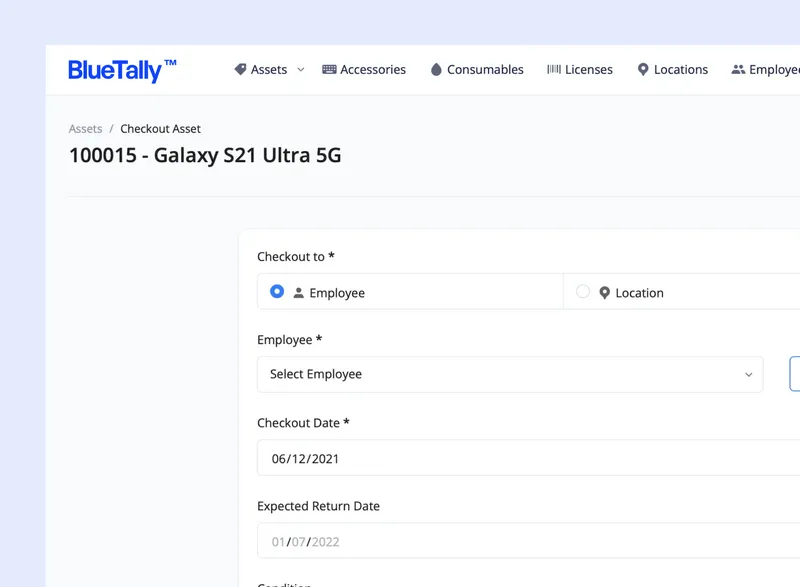
Lifecycle Management
Lifecycle management encompasses the entire journey of a mobile device, from procurement and deployment to maintenance and eventual disposal or recycling.
BlueTally facilitates this by allowing users to document each stage of the asset's life. You can track warranties, maintenance schedules, and replacement needs, ensuring that devices are utilized to their fullest potential and replaced when necessary.
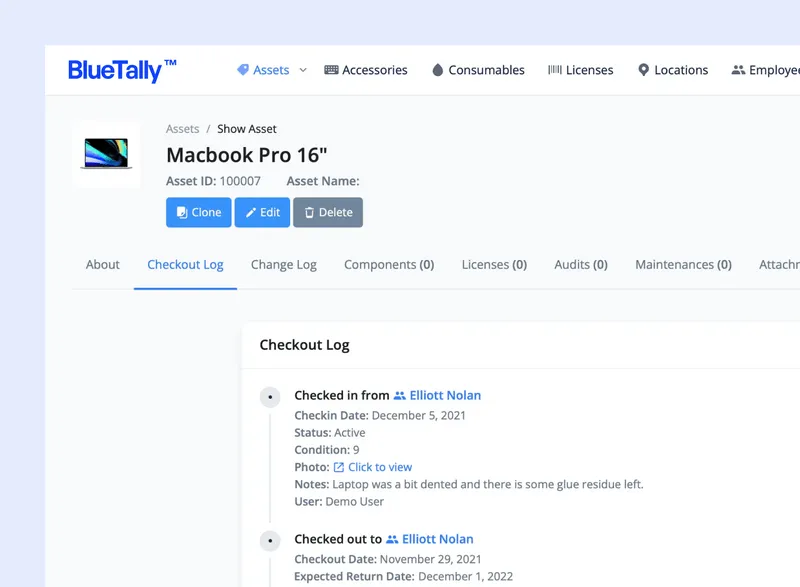
Security
With sensitive data often stored on mobile devices, implementing robust security measures is crucial. This includes remote wiping capabilities, encryption, and access controls to protect data from unauthorized access.
BlueTally enhances security by providing role-based access controls, ensuring that only authorized personnel can modify asset information. Additionally, it enables users to log security incidents and track the condition of assets over time.
Monitoring and Reporting
Continuous monitoring of mobile assets allows organizations to assess usage, performance, and condition. By generating detailed reports, businesses can make informed decisions regarding asset management.
BlueTally offers comprehensive monitoring tools that track asset usage patterns and generate reports, helping organizations identify trends and optimize resource allocation.
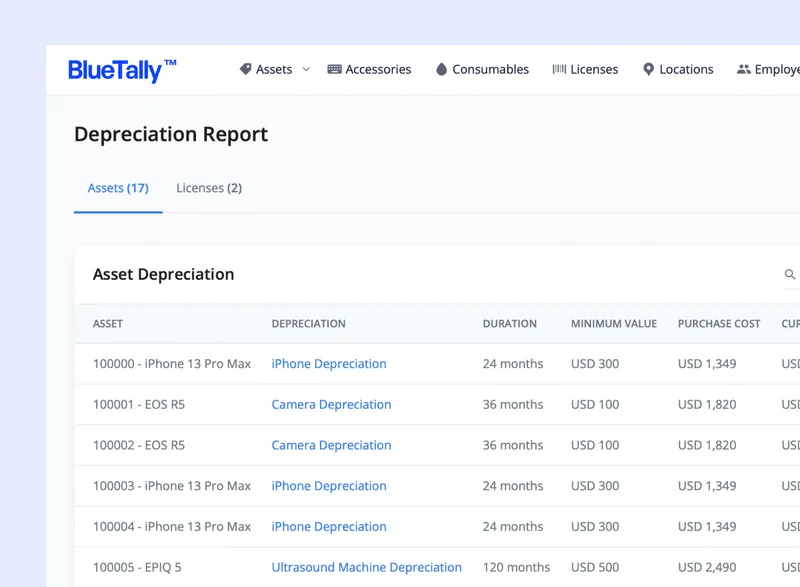
Software Management
Managing applications installed on mobile devices is vital for maintaining compliance with organizational policies. This includes overseeing updates, licensing, and ensuring that software is used effectively.
With BlueTally, users can easily manage software licenses, track compliance, and assign licenses to specific devices or users, simplifying software management across the organization.
Cost Management
Analyzing costs associated with mobile assets, including acquisition, maintenance, and operational expenses, to optimize budget allocation. By tracking the cost associated with each asset, you can make data-driven decisions on future investments and budget allocations.
Integration
Integrating MAM with other systems and tools can enhance efficiency and data accuracy. BlueTally seamlessly integrates with various platforms, including Azure Active Directory, Intune, and others, allowing for streamlined workflows and data consistency across the organization.
This connectivity ensures that all asset-related information is up-to-date and accessible, reducing the risk of errors and duplication.
Benefits of Mobile Asset Management
Improved Asset Visibility
MAM systems provide real-time tracking of mobile devices, offering insights into their location, status, and usage. This visibility helps organizations know exactly where assets are and who is using them, which reduces the risk of loss or theft.
Enhanced Security
MAM ensures that mobile devices are secure through features like remote data wiping, encryption, and enforcing security policies. This minimizes the risk of data breaches and ensures compliance with security regulations.
Cost Optimization
By tracking and managing mobile assets, organizations can optimize their spending on devices, data plans, and other associated costs. MAM helps identify unused or underutilized devices, enabling cost reduction.
Increased Operational Efficiency
Automated device management tasks, such as software updates, configuration, and monitoring, reduce the workload on IT teams and ensure devices are always up-to-date and functioning optimally.
Extended Device Lifecycle
MAM solutions ensure that devices are properly maintained, updated, and supported, which extends their operational life. This reduces the need for frequent replacements and helps manage the total cost of ownership.
Better Compliance
MAM systems help ensure that mobile devices comply with internal policies and external regulations. This includes managing software updates, monitoring licensing, and enforcing security policies like password protection and encryption.
10 Steps for Implementing Mobile Asset Management
1. Define Clear Asset Management Policies
Establish comprehensive policies for the use, maintenance, and security of mobile assets. This includes defining rules for personal device usage (BYOD), authorized applications, security protocols, and acceptable usage guidelines.
2. Choose the Right MAM Solution
Select a solution that aligns with your organization's needs. Evaluate different Mobile Asset Management solutions based on features such as device tracking, security management, app management, and cost control.
For instance, at BlueTally, we provide a comprehensive range of features designed to streamline asset management of all kinds. Our real-time asset tracking allows you to monitor the status and location of devices effortlessly, while custom fields enable you to capture specific information relevant to your operations.

3. Implement Strong Security Measures
Protect mobile assets by enforcing stringent security measures. This includes device encryption, remote wipe capabilities for lost or stolen devices, password protection, and lockdown features to restrict unauthorized app access. Ensuring these security measures are in place protects sensitive corporate data and enhances overall security posture.
4. Enable Remote Monitoring and Management
Utilize tools that allow IT teams to remotely manage, troubleshoot, update, and secure devices. This capability ensures a quick response to issues and minimizes downtime, particularly for remote or mobile workers.
5. Track and Monitor Mobile Asset Usage
Implement real-time tracking of mobile assets to monitor device usage, locations, and performance. This helps prevent theft, loss, and misuse while optimizing asset allocation.
6. Create a Mobile Device Inventory
Maintain a detailed inventory of all mobile assets, including device type, model, assigned users, and lifecycle stage (e.g., active, in repair, or retired). This helps in tracking and managing devices effectively over their lifecycle.
7. Segment Business and Personal Data (For BYOD)
If you allow employees to use their own devices (BYOD), ensure there’s a clear separation between personal and corporate data. Use containerization to isolate work data from personal apps to protect sensitive information without infringing on employee privacy.
8. Implement Role-Based Access Controls
Grant access to mobile assets based on job roles and responsibilities. This approach minimizes unnecessary access to sensitive data or applications, reducing security risks and ensuring that users have only the permissions they need to perform their tasks.
9. Conduct Regular Audits and Reviews
Periodically audit your mobile asset management practices to assess compliance with established policies and identify areas for improvement. Review device usage data, security incidents, and operational efficiency to refine your MAM strategy.
Tools like BlueTally can help schedule and track these audits efficiently, providing comprehensive reporting and insights.
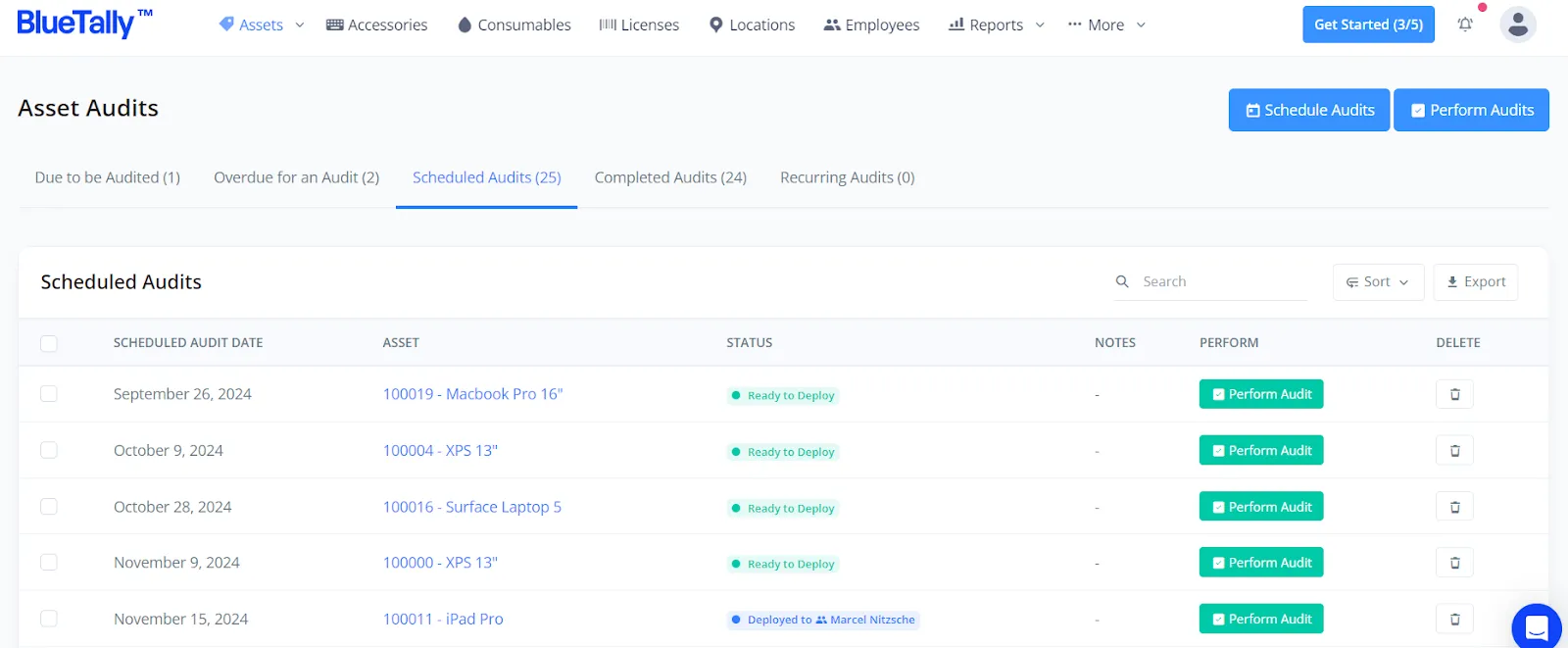
10. Leverage Integrations
Integrate your MAM system with other platforms to streamline workflows and automate data imports, improving efficiency and reducing manual errors.
BlueTally's integrations with Microsoft Intune facilitate seamless device management and policy enforcement. Our compatibility with Jamf ensures smooth management of Apple devices, while integrations with communication tools like Slack enhance collaboration among team members, providing real-time updates on asset management.
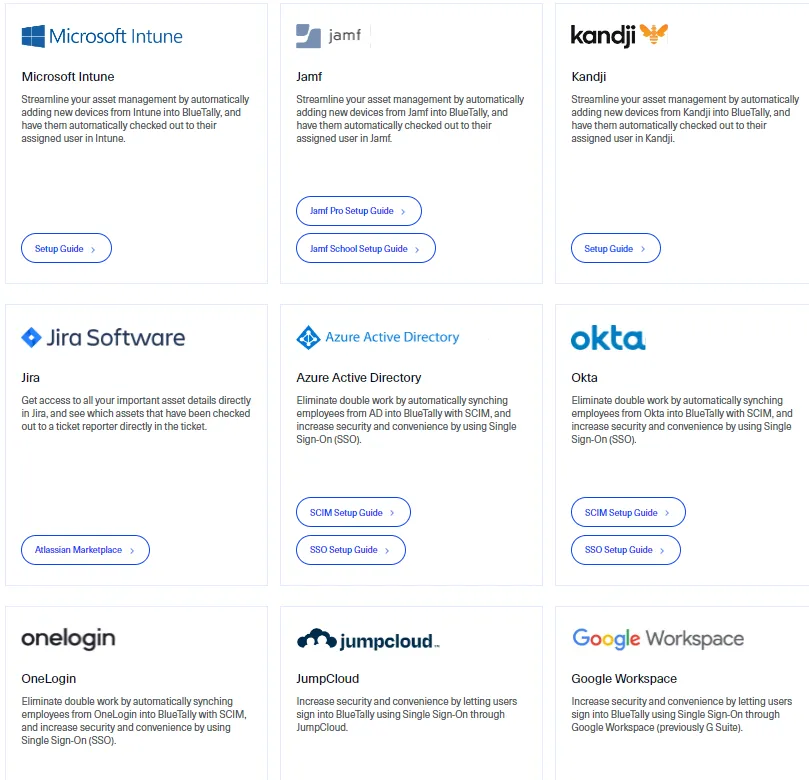
BlueTally is Your Go-To Mobile Asset Management Solution
Mobile Asset Management (MAM) is essential for organizations aiming to effectively track, manage, and optimize their mobile assets, which include smartphones, tablets, laptops, and other technologies used by employees.
By adopting best practices and utilizing a dependable tool like BlueTally, you can gain better control over your mobile assets, leading to increased efficiency, cost reduction, and improved compliance.
Ready to simplify your mobile asset management? Try BlueTally for free today!






